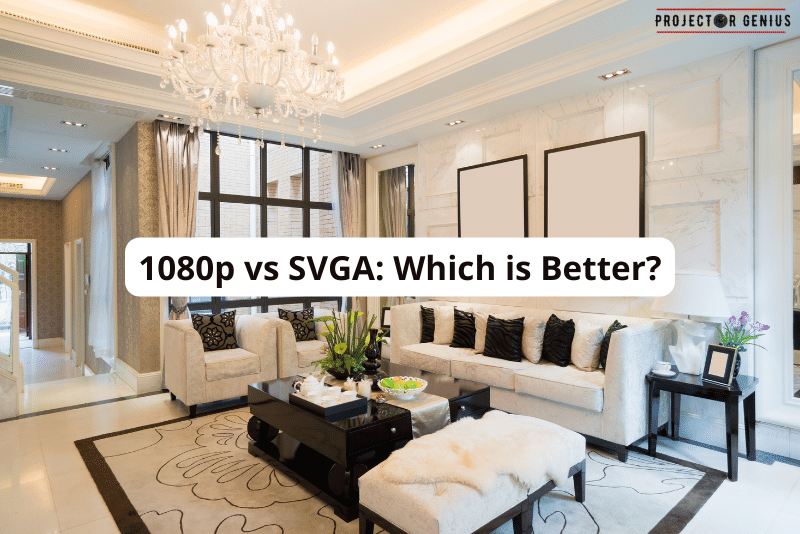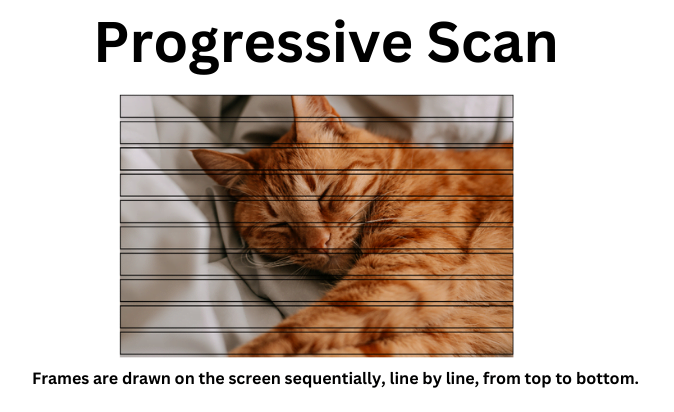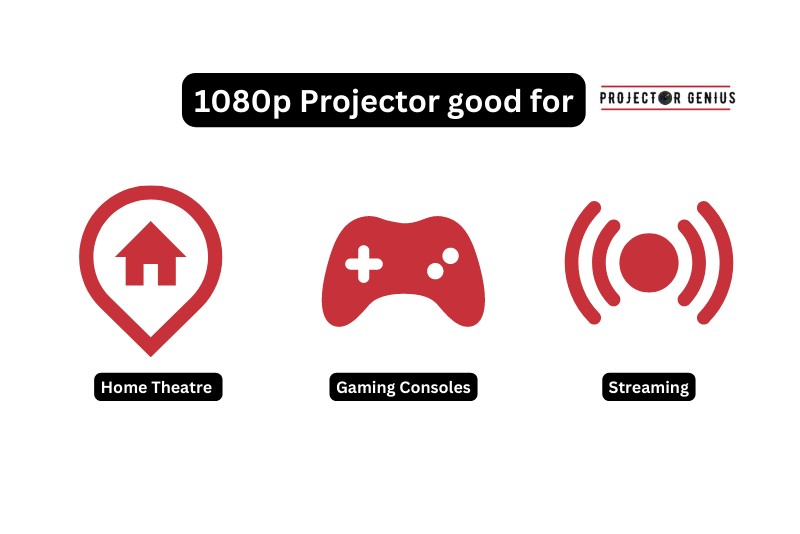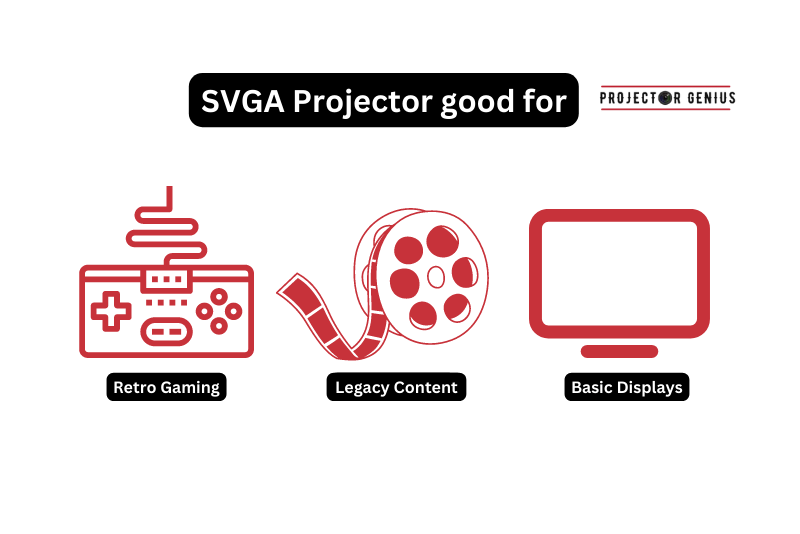1080p vs SVGA: Which is Better?
-
 Written by:
Kristy Roger
Written by:
Kristy Roger
- Last Updated:
So, you’re wondering which is the best 1080p vs SVGA.
Throughout this article, I’ll talk you through the detailed knowledge of 1080p or SVGA. I’ll also help you decide which Resolution works best for you.
1080p vs SVGA? 1080p is better than SVGA. It offers higher resolution and better image quality, making it a superior choice for modern displays and content consumption.

I recommend using the Table of Contents to quickly access the information you need.
My article is designed to cater to home cinema users of all levels, from Beginners to Advanced enthusiasts.
Table of Contents
What is 1080p?
1080p is a high-definition video display resolution format. The “1080” refers to the number of vertical lines, and the “p” stands for progressive scan.
In 1080p, each frame of the video is drawn on the screen in a single pass. This means that every frame contains the complete picture, resulting in a smooth and detailed image. It offers a substantial improvement in image quality compared to standard-definition formats like 480p or 576p.
Specifically, 1080p has a resolution of 1920 pixels in width and 1080 pixels in height, providing a total pixel count of over 2 million. This format is commonly used in high-definition television (HDTV) broadcasts, Blu-ray discs, digital streaming services, and gaming consoles.
1080p provides a high level of visual detail, making it suitable for a wide range of applications including television broadcasting, streaming video, gaming, and various forms of multimedia content. It’s a standard format for many modern televisions and computer monitors.
What is SVGA?
SVGA stands for Super Video Graphics Array. It is a display resolution standard commonly used in computer monitors and projectors.
SVGA provides a resolution of 800×600 pixels, which means there are 800 horizontal pixels and 600 vertical pixels, resulting in a total of 480,000 pixels on the screen. This resolution was a significant improvement over older VGA (Video Graphics Array) standards, which typically offered a resolution of 640×480 pixels.
While SVGA is considered low by today’s standards, it was a popular and widely used resolution in the late 1990s and early 2000s. It provided a good balance between image quality and performance for many applications, including office work, basic graphics, and early video games.
Today, SVGA has largely been surpassed by higher-resolution standards like XGA (1024×768), WXGA (1280×800), and Full HD (1920×1080), which are common in modern displays and projectors.
1080p vs SVGA: Differences Between 1080p and SVGA
1080p and SVGA are two different resolutions commonly used in displays, and they have significant differences in terms of pixel count, aspect ratio, and typical use cases. Here’s a breakdown of the key differences between the two:
Resolution
1080p (Full High Definition or FHD): 1920 pixels horizontally by 1080 pixels vertically. This results in a total of 2,073,600 pixels.
SVGA (Super Video Graphics Array): 800 pixels horizontally by 600 pixels vertically. This results in a total of 480,000 pixels.
Aspect Ratio
1080p: Has an aspect ratio of 16:9. This is considered widescreen and is the standard for most modern TVs, computer monitors, and video content.
SVGA: Has an aspect ratio of 4:3. This is more square-shaped and was the standard for older computer monitors and displays.
Common Usage
1080p: Commonly used in modern high-definition television (HDTV), Blu-ray discs, video streaming services, computer monitors, and some gaming consoles. It provides high-quality video and is considered standard for many applications.
SVGA: Historically, SVGA was a standard resolution for computer monitors, especially in the early days of personal computing. However, it’s considered low resolution by today’s standards.
Quality and Clarity
1080p: Provides higher resolution and clarity compared to SVGA. It’s capable of displaying finer details and is suitable for high-quality video playback.
SVGA: Offers lower resolution and clarity compared to 1080p. It may appear pixelated when displaying detailed images or text.
Application
1080p: Suitable for a wide range of applications including watching high-definition videos, gaming, graphic design, and general computing tasks. It’s the standard for most modern displays.
SVGA: Nowadays, SVGA is considered somewhat outdated for most applications. It might still be used in specific situations, such as in older projectors or legacy systems.
Compatibility
1080p: Most modern devices and displays support 1080p. It’s a widely adopted standard.
SVGA: While still supported by some older devices and projectors, SVGA is less commonly used in modern setups.
In summary, 1080p offers significantly higher resolution and clarity compared to SVGA, making it the preferred choice for most modern applications. SVGA, on the other hand, is a lower-resolution standard that was more common in the early days of computing but has largely been replaced by higher-resolution standards like 1080p.
Factors to Consider When Choosing Between 1080p and SVGA
When choosing between 1080p and SVGA, there are several important factors to consider. Your decision should be based on your specific needs, preferences, and the devices or applications you plan to use. Here are the key factors to take into account:
Intended Use
Consider what you will primarily be using the display for. For high-definition video playback, gaming, or graphic design work, 1080p is generally the better choice due to its higher resolution and clarity. If you’re using it for basic computing tasks or legacy applications that don’t require high resolution, SVGA might suffice.
Device Compatibility
Ensure that the device you’re connecting to (e.g., computer, gaming console, DVD player) and the display (e.g., monitor, TV, projector) are compatible with the chosen resolution. Most modern devices support 1080p, but some older or specialized equipment may only support SVGA.
Content Source
Consider the source of your content. If you plan to watch high-definition movies, stream videos from platforms like Netflix or play modern video games, 1080p is essential for experiencing the content as intended. SVGA may not provide an optimal viewing experience for high-definition content.
Budget
SVGA displays are generally less expensive than 1080p displays. If cost is a significant factor and you don’t require high resolution, SVGA might be a suitable choice.
Aspect Ratio
Consider the aspect ratio of the display. 1080p has a widescreen 16:9 aspect ratio, which is standard for modern content and provides a more immersive viewing experience. SVGA has a more square-shaped 4:3 aspect ratio, which may not be ideal for widescreen video content.
Graphic Intensity
If you’re planning to run graphics-intensive applications or play modern video games, 1080p is almost a necessity. The higher resolution allows for more detailed and immersive visuals.
Legacy Systems or Applications
If you’re working with older systems or software that are optimized for lower resolutions like SVGA, compatibility might be a consideration.
Future-Proofing
Consider future upgrades and developments. While 1080p is currently the standard, higher resolutions like 4K are becoming more prevalent. If you plan on keeping your display for a long time, investing in a higher resolution might be a more future-proof choice.
Viewing Distance
Consider how far you’ll typically be from the display. If you’re sitting relatively far away, the difference in resolution might be less noticeable.
Ultimately, the choice between 1080p and SVGA will depend on your specific needs and circumstances. It’s important to weigh these factors against each other to make an informed decision that aligns with your intended use and budget.
FAQ (Frequently Asked Questions)
Is 1080p Resolution Better than SVGA for all Applications?
Yes, 1080p resolution is better than SVGA for most applications. The extra pixels in 1080p make images and videos sharper and clearer. It’s like the difference between looking through a clean window and a slightly fogged one. For watching movies or playing video games, 1080p offers a more immersive experience. The details pop, colors are vibrant, and characters come to life in a way that SVGA simply can’t match.
However, it’s important to note that there are some cases where SVGA might be sufficient. If I’m using an older computer or software that’s optimized for lower resolutions, SVGA could still get the job done. Plus, if budget constraints come into play, SVGA displays tend to be more affordable. But for most modern applications, whether it’s streaming videos, working on documents, or even browsing the web, 1080p is the clear winner. It provides a crisper and more enjoyable visual experience across the board.
Can I Connect a Device with 1080p Output to an SVGA Monitor?
No, connecting a device with 1080p output to an SVGA monitor might not work smoothly. The SVGA monitor has a lower resolution, so it might struggle to display the higher quality visuals from the 1080p device. The images might appear stretched or pixelated, making it hard to see details clearly.
In my experience, it’s often better to use a monitor that matches the device’s output resolution. This way, I can enjoy the content as it’s meant to be seen, without any loss in visual quality. If I try to connect a 1080p device to an SVGA monitor, I may end up missing out on the finer details and vibrant colors that the higher resolution provides.
Which Resolution is Recommended for Presentations: 1080p or SVGA?
For presentations, I’d definitely recommend using 1080p resolution. It offers much clearer visuals and sharper text compared to SVGA. This means that charts, graphs, and text will be more legible, ensuring that my audience can easily follow along with the content.
When I use 1080p for presentations, the images and videos I incorporate appear crisp and vibrant. This can greatly enhance the overall impact of my presentation, making it more engaging and memorable for my audience. In contrast, if I were to use SVGA, the visuals might appear pixelated and lack the necessary clarity for a professional presentation. So, in my opinion, 1080p is the way to go for a polished and effective presentation.
How does SVGA Fare in terms of Graphics Quality Compared to 1080p?
In my experience, SVGA falls noticeably short in terms of graphics quality when compared to 1080p. The images and visuals on an SVGA display tend to be less sharp and detailed. This means that fine details in pictures or text can appear somewhat fuzzy or unclear.
When I switch to 1080p, the difference is striking. The graphics are significantly crisper and more defined. Colors appear more vibrant and true-to-life, adding depth and richness to the visual experience. It’s like upgrading from a standard photo to a high-definition print – the improvement in clarity is hard to miss. So, in my honest opinion, when it comes to graphics quality, 1080p is the superior choice without a doubt.
Is 1080p Resolution Suitable for Gaming, or is SVGA Still Viable?
Yes, 1080p resolution is highly suitable for gaming. It offers a sharp and detailed visual experience that enhances the overall gaming immersion. The higher resolution allows for finer details in game graphics and characters, providing a more engaging and realistic gaming environment. Additionally, most modern games are optimized for 1080p, ensuring smooth gameplay and vibrant visuals.
On the other hand, SVGA may not provide an optimal gaming experience. Its lower resolution can result in pixelated and less defined graphics, which can hinder gameplay enjoyment, especially in visually-intensive games. While SVGA might still be viable for very basic or older games, the majority of contemporary gaming experiences are designed with higher resolutions like 1080p in mind. Therefore, for an optimal gaming experience, 1080p resolution is the preferred choice.
Final Thoughts
When comparing 1080p and SVGA resolutions, it is clear that 1080p offers a significantly superior visual experience across various applications. Its higher pixel count and improved clarity make it the preferred choice for modern displays, especially in contexts like gaming, video streaming, graphic design, and presentations. While SVGA may have been relevant in the past, its lower resolution and limited compatibility with modern devices make it less suitable for most contemporary applications.
Considering factors such as intended use, device compatibility, content source, and budget, it becomes evident that 1080p is the more versatile and future-proof option. Its widescreen aspect ratio, vibrant color reproduction, and capacity for displaying finer details ensure a higher quality viewing experience. Therefore, for those seeking an optimal visual experience in today’s digital landscape, 1080p stands as the clear and recommended choice.
Author of this Post:

Kristy Roger
Home Cinema Consultant & Tech Enthusiast
Holding a background in Industrial and Electrical Technology from the University of Alberta, Kristy has spent 5+ years consulting on home theater products at a top electronics firm. As a certified Technical Professional with Lean Six Sigma credentials, Kristy expertise ranges from projector nuances to hands-on experience with leading models. Kristy have been sharing her knowledge online for two years, blending professional insights with personal experiences from her own home cinema setup. Off the screen, She is a dedicated mom to Jerry, Ryan, and our two pups, Cuddle and Paw.






